Wings are made of feathers
My journey in Luxembourg started… in Vianden, which is about an hour away from the capital city. Heading North, you’ll find a mystical place where a beautiful castle seems to be the Guardian of the Our River (which forms the border between Belgium, Luxembourg and Germany) and the – very epic – museum of Victor Hugo. During his stay (a few days in 1851 and a little more than 2 months in 1871), he wrote poems and drew Luxembourgish symbols. Can you spot the difference ?
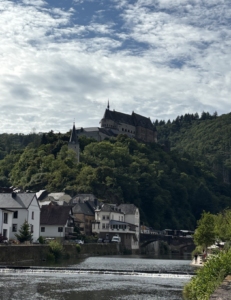
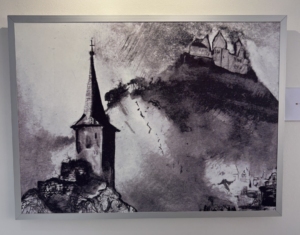
Wonderful, right ?
I went back to the center where I was welcomed by a warm sunset. The city has seen a lot of changes; however, the fortifications of Luxembourg-city – one of Europe’s greatest fortified sites – are still standing, supported by the natural landscape that surrounds them and the legend of Melusina, which perpetuates the myth about the origins of the city, dating back to its foundation by Count Sigefroi in 963. It is quite magical to observe a landscape made up of greenery, mystery, fortifications and modernity!
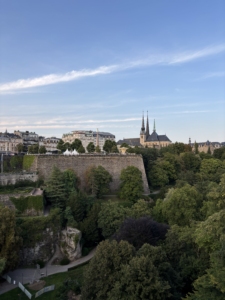
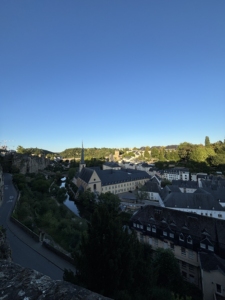
Talking of modernity, the buildings you see in the background of the picture below are located in the Kirchberg district.
Kirchberg is another important part of the city because it is home to a lot of financial institutions, one of the campuses of the University of Luxembourg, but also many cultural attractions, including the philharmonic hall, the museum of modern art, the European Parliament and the Olympic swimming pool!
What is even more surprising and interesting is that, before the expropriation of 1961, Kirchberg was mainly occupied by huge fields where potatoes, lettuce and cabbage were grown. We never would have guessed! It is funny to think that nowadays they kind of grow money there.
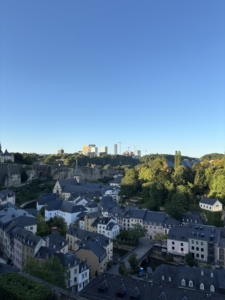
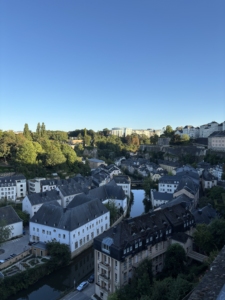
Last but not least, I walked to the Monument Robert Schuman. The monument was unveiled in 1966 – 3 years after Robert Schuman’s death – and consists of 3 girders ending in 6 spikes which represent the six founding states of the European Community for Coal and Steel: Belgium, the Federal Republic of Germany, France, Italy, the Netherlands and Luxembourg. More than a symbol of Luxembourg’s history (his mother tongue was Luxembourgish), Robert Schuman encouraged the idea – as the nations of Europe were trying to overcome the devastation wrought by World War II – that peace can be achieved through unity and that diversity is a strength.
The inscription on the memorial stone is an excerpt from the speech that Schuman held on the 9th of May, 1950 (which is a holiday in Luxembourg, “Europadag” or Europe Day, named after the Declaration). It says : “Europe will not be made all at once, or according to a single plan. It will be built through concrete achievements which first create a de facto solidarity.”
Although, initially, Schuman’s statement had other aims, this quote also invites us to reflect on the human condition, particularly our connections as citizens of Europe and the world.
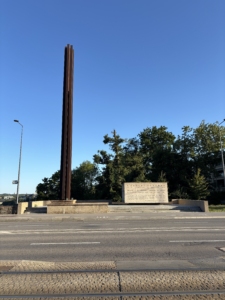
Being born with roots here and elsewhere, travelling, sometimes being forced to leave… these are realities that many people are familiar with. A question came to my mind: from our shared history to our most unique traditions, what constitutes Europe’s identity today? Will historical and cultural heritage provide an answer to this question? Is art or poetry one of them? That is what I will try to discover during my journey…
This is where my stay in Luxembourg comes to an end. From the heights of Vianden to the depths of the Grund, these sites have taken me on another kind of journey through my mind and through matter. Descending the slope of history, then climbing back up to find a present full of modernity, Luxembourg is one of these places that reminds you what is especially beautiful in a world of diversity where you are able to express who you are : that wings are made of feathers, and not only the ones from our dearest writers! Each one of us works hard to make ourselves a pair with what we carry, what we love, what we learn, the languages we speak and the people we meet along the way; for the rest, as long as we will do what is right, like for Icarus, the sky will gives us all the space we need to fly!
See you in Brussels, dear travelling companions!
Sophie


